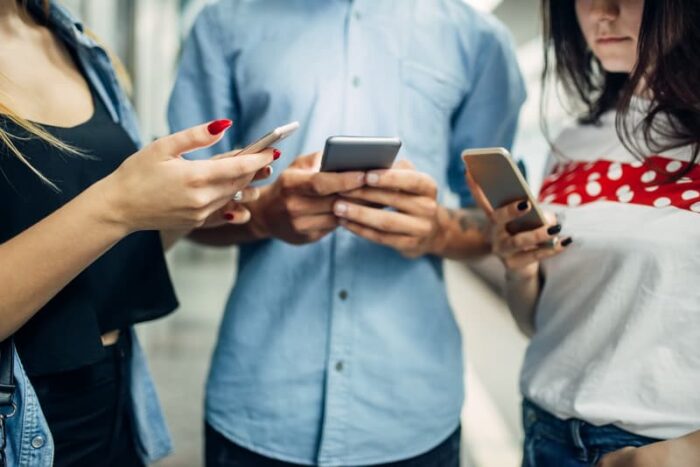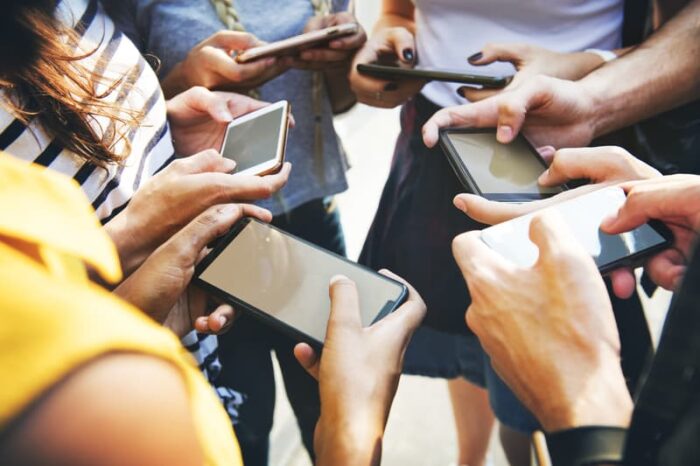- Calls to this hotline are currently being directed to Within Health or Eating Disorder Solutions
- Representatives are standing by 24/7 to help answer your questions
- All calls are confidential and HIPAA compliant
- There is no obligation or cost to call
- Eating Disorder Hope does not receive any commissions or fees dependent upon which provider you select
- Additional treatment providers are located on our directory or samhsa.gov
Is Social Media Use Correlated to a Higher Risk of Mental Illness?

In today’s society we communicate more virtually than ever before. Social media provides opportunities for adolescents to explore peer relationships, gain independence, and discover their identity [2].
The exposure to social media may also have negative impacts potentially putting adolescents at heightened risk for the onset of mental illness. Nearly 1 in 5 adolescents suffer from a mental disorder [2].
New social media platforms are growing like wildfire, and they aren’t going away anytime soon. To healthfully practice using social media, as a tool and not a weapon, we must be aware of the potential benefits and harms.
The Potential Benefits of Social Media
Social Connection
Majority of adolescents aged 13-17 are using social media. The current use of social media includes; YouTube (85%), Instagram (72%), Snapchat (69%) and Facebook (51%) [2].
A recent survey revealed, 77% of adolescents believe social media is “somewhat” important to maintain relationships with friends and support meaningful conversations [2].
Social media does allow increased availability and connectedness to friends and family. This provides an opportunity to instantly communicate with those we love and admire near or far.
Increased socialization via social media may support a heightened feeling of acceptance and minimize feelings of isolation.
Social Support
For today’s youth, who do not yet have peer support, social media may provide a platform for social support. Social support can aid in connecting adolescences with individuals they feel understand and relate to them.
Youth identifying as LGBTQ show increased likelihood to have online peers. These peers act as a source of connection and emotional support [2] when peers in person aren’t always as open minded.
Social support in communities such as these may also aid in supporting mental health. One study found about 50% of psychiatrically hospitalized youth reported receiving online encouragement to get help at least 2 weeks prior to admission [2].
Identity and Intellectual Growth
Social media may provide an avenue for growth by increasing self-expression and educational resources. This is an environment that can help support expression of creativity, opinions, and intellectual growth [1].
Of course, the impact of social media can vary based on the platform being used and the intention behind using it. When someone practices expressing their opinion they must be aware that others may respond with a conflicting opinion.
In some cases this may negatively impact self-beliefs and confidence in future expression. For others, social media provides an avenue to test, refine and improve upon a variety of creative expression [1]. Third, the relationship between social media and creativity varies on the basis of the platform used, the nature of the use and the purpose for using it.
The last set of analyses focusing on the purposes of SM use indicated that creativity-related variables were higher for those who use SM primarily for “ex-pressing their ideas and opinions,” “gleaning topics and information to talk about,” and “self-education and learning” than those whose primary purposes were “entertainment” or “relaxation”.
The Potential Harms of Social Media
Cyber-bullying
Cyber-bullying and rumor spreading have been connected with increased self-harm and suicidal ideation [1].
Victims of cyber bullying may feel they do not have social connection or support in person and now online. This can provoke feelings of exclusion and isolation, increasing the risk of depression.
Online conflict or drama my also plant seeds that if I change who I am and how I look, I may be better accepted. Those vulnerable to these conditions may be at increased rick for developing disordered eating, eating disorders, and body dissatisfaction.
Online Content
Online resources provide a plethora of content that may encourage substance abuse, self-harm, suicide, and more [1]. Social media may magnify peer pressure and unattainable expectations.
A recent study exploring the impact of online content on mental health revealed out of 400 youth 14.8% viewed content promoting suicide and 16.6% reported viewing content promoting self-injury 2 weeks prior to mental health admission [1].
This is not to say social media is the cause of mental health concerns in today’s youth, but that it might act as a catalyst for those vulnerable to the content.
Social Comparison
The highlight reel that is social media only shows the positive aspects of life. Constantly viewing others “happiness,” may lead to dissatisfaction and a belief that the lives of others are so much better.
A study exploring this found the more individuals spent time with friend off of social media, the less they compared themselves to others. Maybe, this supports that we as a society are less fixated on judgment when in person and more likely to be vulnerable.
Studies show online comparisons are associated with increased depressive symptoms [2]. Self-comparison on social media may also put individuals at increased risk for eating disorders and negative body image [2].
Displacing Interests
What are the activities, hobbies, and interests adolescents used to have that social media has now replaced? The time spent on social media, no doubt, is taking away from other experiences.
The amount of time online has been linked to anxiety, depression and decline in sleep quality [2]. Social media has also shown to have an addictive affect. Leaving some youth to have increased emotional investment in social media and feeling upset when it’s inaccessible [3].
The time invested in social media may be time lost with friends and family. It may also be time lost resting or enjoying the world outside of the virtual universe.
Placing Boundaries Around Social Media
The increase in mental health concerns has coincided with the explosion of social media. This raises concern, is social media a cause?
Think about how much time is spent on social media. Recent studies found those who spent more than three hours per day online or went on social media more than three times per day were at higher risk for mental health concerns [3].
Research is not available to show who is most vulnerable to the harmful effects of social media. Social media is a tool that for some can be used beneficially, but vulnerabilities may lead others to maladaptive responses [1].
To explore if boundaries need to be set around social media try asking yourself or a loved one a couple questions:
- How much time do I spend on social media?
- When I login to social media do I feel better or worse about my life?
- Do I use my phone up until I go to bed?
- Do I wake up in the middle of the night to check my phone?
- If I was in person, would I speak to someone this way?
- When is the last time I met up with someone I care about?
- Where am I spending my time on social media and what is the content?
If you aren’t comfortable with your own answers, now is the time to make a goal to put down your device and explore what you might be missing or disconnected from.
Resources:
[1] Acar, S., Neumayer, M., & Burnett, C. (2019). Social Media Use and Creativity: Exploring the Influences on Ideational Behavior and Creative Activity. The Journal of Creative Behavior, 55(1), 39–52. https://doi.org/10.1002/jocb.432 [2] Nesi, J. (2020). The Impact of Social Media on Youth Mental Health. North Carolina Medical Journal, 81(2), 116–121. https://doi.org/10.18043/ncm.81.2.116 [3] Teens and social media use: What’s the impact? (2019, December 21). Mayo Clinic. https://www.mayoclinic.org/healthy-lifestyle/tween-and-teen-health/in-depth/teens-and-social-media-use/art-20474437About the Author:
 Raylene Hungate, RD/N, LD/N is a registered dietitian dedicated to providing the utmost care and support to those struggling with mental health. As a supporter of the Health at Every Size movement and the idea that all foods fit, she is passionate about helping others explore a life full of nourishment and bursting with flavor.
Raylene Hungate, RD/N, LD/N is a registered dietitian dedicated to providing the utmost care and support to those struggling with mental health. As a supporter of the Health at Every Size movement and the idea that all foods fit, she is passionate about helping others explore a life full of nourishment and bursting with flavor.
As an eating disorder dietitian, Raylene works not only in Private Practice, but also as a dietitian for an eating disorder treatment center in Los Angeles, California. She finds great joy in guiding others through an empowering journey of self-discovery and healing.
The opinions and views of our guest contributors are shared to provide a broad perspective on eating disorders. These are not necessarily the views of Eating Disorder Hope, but an effort to offer a discussion of various issues by different concerned individuals.
We at Eating Disorder Hope understand that eating disorders result from a combination of environmental and genetic factors. If you or a loved one are suffering from an eating disorder, please know that there is hope for you, and seek immediate professional help.
Published June 17, 2021 on EatingDisorderHope.com
Reviewed & Approved on June 17, 2021, by Jacquelyn Ekern MS, LPC

